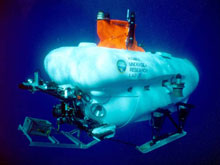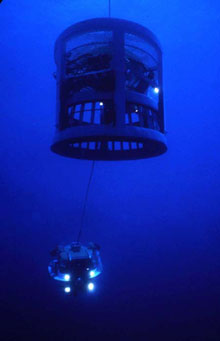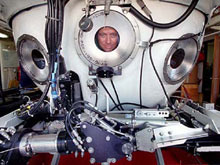
Pisces IV submarine, viewed from underwater. Click image for larger view.
One of the Pisces crew looking out the porthole of the submersible. Click image for larger view.
PISCES Manned-Submarines and the RCV-150 Remotely Operated Vehicle (ROV)
Bill Chadwick
Oregon State University
NOAA Vents Program
During the New Zealand-American Submarine Ring of Fire 2005 expedition our primary observation and sampling tools will be two deep-diving submarines named PISCES IV and PISCES V. The two submarines are almost identical and both will be on board the support ship, the R/V Ka'imikai-o-Kanaloa (or K-O-K for short). Usually only one submarine is used at a time and the other is available as a backup or for emergencies. The PISCES submarines carry 3 passengers (usually a pilot and two observers) down to a maximum depth of 2000 meters (6500 feet) during dives that typically last 6-10 hours. In between dives, a small remotely operated vehicle (the RCV-150) can be used to explore potential sites for future dives.
We will be making PISCES dives at some of the volcanoes in the Kermadec Arc that have been previously found to be hydrothermally active. The main tasks for PISCES during these dives will be to: 1) first, locate the hot springs on the seafloor and determine their character and extent, 2) examine the biological community around each vent site for unique species, 3) investigate the physical setting of the vents in order to understand why they are located where they are, 4) sample the hydrothermal fluids for chemical and microbiological analysis, and 5) map the site to understand the recent history of the volcano and how it relates to the vent sites.

Underwater view of the small remotely operated vehicle RCV-150 as it is deployed from its steel cage. Click image for larger view.
Some of the tools that PISCES will use for these tasks include: color video cameras and a 3 megapixel digital still camera (for recording visual observations of the seafloor), a high-resolution scanning sonar (for detailed mapping of vent sites), a hot fluid sampler (for taking samples of the hot spring fluids), a pressurized microbial sampler (that can keep samples at high pressure), and a sample basket and slurp sampler (for collecting biological and geological specimens). The most valuable tool is perhaps the simplest: the human eye will allow us to see in three dimensions what is down there as we explore the seafloor. There is nothing quite like looking out a porthole and seeing the wonders that exist at the bottom of the ocean
Visit the technology section of the Ocean Explorer Web site for more information on the PISCES submersibles and the RCV-150 remotely operated vehicle.
Sign up for the Ocean Explorer E-mail Update List.



























